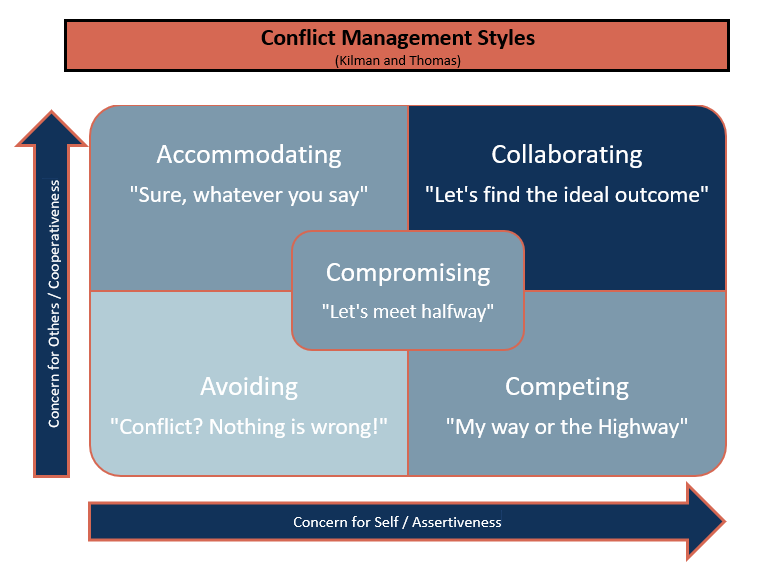Your Conflict Management Styles Toolbox

7 Things Leaders Need To Know About Effective Conflict Management
February 18, 2021THIS is my favourite part of Conflict Management! Understanding and applying different Conflict Management styles help leaders to manage conflict more effectively.
These different styles are like a toolbox. Each style has its place. There is no perfect style because each situation is different. Therefore, it is crucial to understand and apply each style so you can manage conflict more effectively.
Let’s have a look at the five conflict management styles according to Kilman and Thomas.
1. Avoiding – “Conflict? Nothing is wrong!”
Whenever I ask my clients and students what their default style is it is often ‘Avoiding’. This style is common for those that see conflict as bad, do not like confrontation, simply want to keep the peace or those that do not feel confident enough to use the other styles.
Knowing when to avoid a conflict is a skill I have had to learn over the years. Once I learned that conflict is good and necessary, I went a bit overboard. We do not need to escalate every issue. Some conflicts disappear without our interference.
The problem with avoiders can be that you do not assert yourselves to pursue you interests nor cooperate in helping others to pursue theirs. It is usually counterproductive and leads to more conflict.
In leadership, this style is helpful if the matter is trivial or the conflict could cause more damage than necessary outcomes. A leader needs to be able to discern whether a conflict is worth having or not.
2. Accommodating – “Sure, whatever you say.”
Same as avoiding, both competing and accommodating are necessary at times because sometimes we need to stand up for what we believe (competing); and sometimes it is not worth fighting over a cause that might be better solved by accommodating another person.
Accommodating is a highly cooperative yet rather unassertive conflict management style. If genuine, it can lead to harmony and avoid unnecessary competition.
Another advantage of this style is that it resolves conflict faster. However, someone who is accommodating often sacrifices not only their own values but also potential “higher-quality decisions in order to maintain smooth relationships” (Northouse, 2020).
This style is not a common style leaders use when the matter is resource-related. Leaders usually have the responsibility to make decisions instead of letting others make the call. If the matter is identity-related, which means the conflict might concern a person’s personal issues, leaders might accommodate less confident people, for example, to approve their self-worth.
3. Competing – “My way or the highway”
Competing might be mistaken for a leadership mantra. However, the issue is that the concern for others is very low. As much as leaders must often make the final decision, this style is a ‘win-lose’ strategy.
This style is often a very controlling style to solve conflicts that only benefits one’s own goals. It can involve hostile communication and lead to counterproductive results where people feel manipulated or mistrusting.
To manage a conflict by competing might be necessary when a quick solution is required but it is not recommended as a general conflict management style.

4. Compromising – “Let’s meet halfway”
The compromising style is often seen as the best result. We often hear that ‘we just need to compromise’ to resolve a conflict. However, it is not the ideal outcome of a conflict.
This style is good because both parties are open to both assert their own needs and cooperate with others. A compromise is often a ‘good enough’ solution and can provide ‘an easy way out’ when both sides sacrifice equally.
It is an effective style if we do not have the time or energy to go further and find the ideal outcome (collaborating).
However, when we compromise, we miss out on what we could achieve if we pursued further options and neither sides are completely satisfied. Often, the discomfort of having a conflict or the need for harmony lead to a quick resolution which is not the optimal outcome for either party.
5. Collaborating – “Let’s find the ideal outcome”
Many people are not aware that compromise is not the best we can achieve in conflict management. The collaborating style leads to ‘win-win’ situations where the result satisfies both sides. It is the most preferred style in any conflict.
Collaborating involves both parties to think beyond their current ideas and find creative ways to solve a conflict. It is when both sides can fully consider the concerns of each other while not sacrificing their own.
This style is highly advantageous for teams to be innovative and work together more effectively. The results are often more cost-effective as there is a greater return on investment, and relationships are being strengthened in the process.
The downside of the collaborating style is that it not only demands time and effort, but it is also difficult to achieve. It requires both sides to be equally committed to the process, identify where they agree and find new ways to look at each other’s concerns. Effective communication is essential for this style to be successful.
Another challenge is to discern when the ideal outcome is achieved. We need to avoid dragging the conflict on unnecessarily and finally resolve the conflict. Both sides need to agree with the solution and walk away with a better result than if they had compromised.
Conclusion
As mentioned before, each style can be effective in a variety of conflict situations. There are advantages and disadvantages to each style and the ideal style depends on the needs of everyone involved and the demands of the circumstances.
Find out more about the 7 principles leaders need to know about effective conflict management in my recent blog post.
Would you like to apply these Conflict Management styles that help leaders to manage conflict more effectively? Just contact me or book your strategy session here.
Happy Thursday!
Désirée


